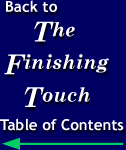

|
|
The
Art of Folding
by Randy Rasch
Whether youre folding in-house or using an outside vendor, pre-thought
is indeed necessary for good folding. That holds true for the single-sheet
letter and the 48-page signature. Of course, the larger the sheets or
the greater the number of folds, the more meticulous the layout, and the
more considerations for design, layout and stripping.
Signatures that are eight pages or greater can be folded in parallel or right angle formats. Parallel fold, referred to as running eights, are more exacting and so used when the pieces contain line-ups or hairline gutter jumps. Larger size books and larger signatures are typically folded in right angle impositions.
Sometimes the choice of parallel or right angle is merely at the discretion of the folder operator; sometimes its due to restrictions of the folders itself. But always, there is a way to make a job difficult or easy, expensive or cost-efficient. Your folder operator can help you with the latter. And without exception, the formula will include consideration of the use, quality, size, and grain direction of the piece.
USE: If the folded piece is the final product, the quality and exactness of the fold is critical. If the folded piece is to be saddle stitched or perfect bound, then the folding must meet the specifications of the binding process.
QUALITY & SIZE: For high-volume runs, time and expense can oftentimes be saved by running the job 2-up and slitting. The cost in printing may be slightly higher, but the savings in folding may be many times the extra expense.
Let's take, for example, a job of 200,000 sheets, 8 1/2" X 11", that are to be letter folded. With this quantity, some may choose to save a printing plate by running the job 2-up on 11" X 17", work and turn where each sheet has one front and on back on each side. True, money is saved in printing, but squandered in finishing, since the job must be cut to singles to be folded. The better option would be to run two fronts and two backs designed to fold 2-up and slit apart on the folder. Here, you save half the folding and approximately 6.5 hours, all for the cost of one extra printing plate. This way may not always be cost-effective for short runs, but it is an option that must be explored before the ink hits the paper.
GRAIN DIRECTION: Folds should always be made "with the grain" of the stock. The heavier the stock, the more important that the grain direction be right. But even lightweight stocks can cause problems if they contain embedding patterns as in a classic laid finish. Very simply, folding can literally "make or break" the quality of any piece and the cost-efficiency of any project. Folding should never be considered as an afterthought to printing, but as a preliminary to design. Call your local trade bindery for input, or simply call Rasch Graphic Services Corporation to help avoid needless problems in folding.
About Rasch Graphics | More
Information
PUR Binding | Perfect
Binding | Saddle Stitching | Mechanical
Binding
Tab Cutting | Support
Services | The Finishing Touch Newsletter
EMail RGS | Home
Page
![]()
![]()
7211 N. Gessner Drive • Houston, TX 77040-3143
Phone: 800 / 713-785-5750 • Fax: 800 / 713-785-5801